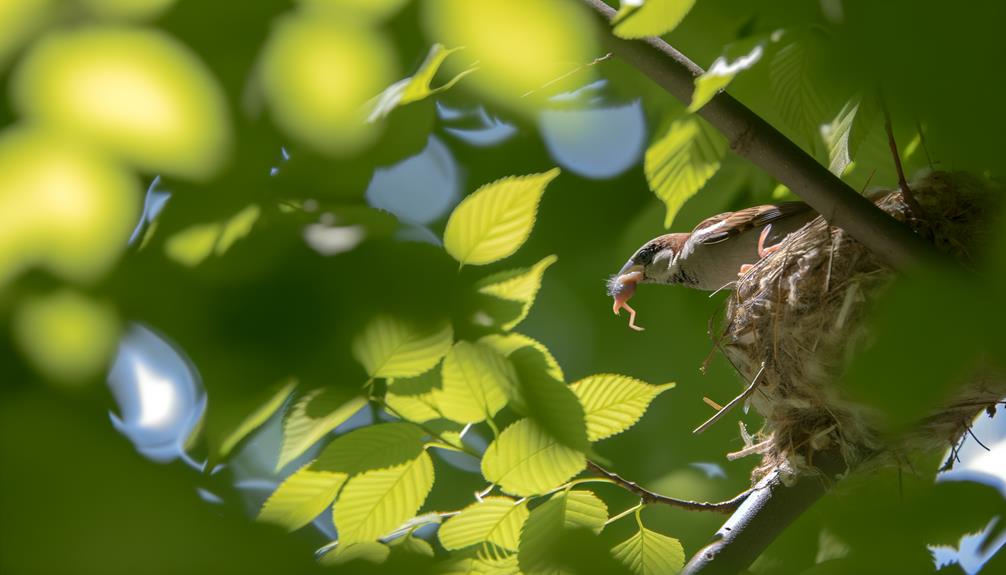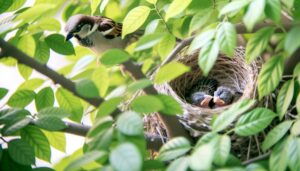How Sparrows Move Their Babies: Nestling Management
Yes, sparrows can relocate their babies. They do this to protect them from dangers like predators, severe weather, or parasitic infestations.
Both parents are involved in this process, working together to ensure the chicks' safety. When the nest is compromised, they transfer the young to a more secure site.
Scientific studies and field observations confirm these behaviors, showing sparrows effectively relocate their chicks to safeguard them. This parental action is essential for survival.
Learning about these behaviors reveals the remarkable strategies sparrows use to nurture their offspring. Explore more to understand how sparrows, like many birds, protect their young.

Key Takeaways
- Sparrows can relocate their chicks to protect them from predators and harsh weather.
- Both sparrow parents share the responsibility of moving their chicks when necessary.
- Relocation is prompted by threats like predation, extreme temperatures, and parasitic infestations.
- Field observations and studies confirm sparrows' purposeful methods for moving their young.
- Understanding sparrows' relocation behaviors enhances appreciation for their survival strategies.
Sparrow Nesting Habits

Sparrows typically build their nests in sheltered locations like tree cavities, eaves of buildings, or dense shrubbery. You'll find they choose these spots to protect their young from predators and harsh weather.
When you observe sparrows, notice the materials they use: grasses, twigs, and even bits of paper. This diverse selection ensures a sturdy and insulated home.
As someone who wants to help, consider how you can support their nesting habits. Leave out small materials for them to use or plant dense shrubs to provide safe nesting sites.
Avoid disturbing their chosen nesting areas; your respect for their space can significantly reduce stress on these tiny creatures, allowing them to thrive and raise their young safely.
Parental Roles in Sparrows
In the world of sparrows, both parents actively share the responsibilities of incubating eggs and feeding their hungry nestlings. You'll find the male and female working in tandem, ensuring their young are warm and well-nourished.
While the female typically incubates the eggs, the male is often seen gathering food and standing guard. After hatching, both parents tirelessly feed the chicks, bringing a variety of insects and seeds to the nest. Their teamwork is vital for the survival of their offspring.
You can appreciate how these small birds embody dedication and cooperation, balancing their roles seamlessly. By observing sparrows, you'll see a perfect model of shared parental duties, reflecting a truly collaborative approach to nurturing their young.
Reasons for Moving Chicks

When faced with threats like predators, harsh weather, or parasitic infestations, sparrow parents may relocate their chicks to guarantee their safety and well-being. Relocating their young allows sparrows to address immediate dangers effectively and safeguard their offspring's survival.
Sparrows might move their chicks for several critical reasons:
- Predators: If a nest is discovered by a predator, moving the chicks reduces the risk of predation.
- Harsh Weather: Extreme temperatures or storms can endanger chicks, necessitating relocation to a more sheltered spot.
- Parasitic Infestations: Infestations can weaken or kill chicks, so parents may move them to a cleaner environment.
Observations and Studies
Detailed field observations and rigorous scientific studies have shed light on the fascinating behaviors sparrows exhibit when relocating their chicks.
You'll find that researchers meticulously track sparrow movements, noting instances where adult sparrows carry their vulnerable young to safer locations. Using tiny tracking devices and high-resolution cameras, scientists have documented sparrows picking up their chicks with their beaks and flying short distances to evade predators or environmental hazards.
Additionally, controlled experiments in aviaries confirm these findings, showing that sparrows have a clear, purposeful method for moving their young.
Your understanding of these avian behaviors can enhance your appreciation for the intricate ways sparrows secure the survival of their offspring. This knowledge empowers you to support and protect these remarkable birds.
How Other Birds Compare

Many bird species exhibit unique methods for relocating their young, and understanding these can provide a broader perspective on avian parental care. For example, some birds have evolved remarkable strategies to ensure the safety and well-being of their offspring.
- Owls: Female owls are known to carry their chicks between two locations using their talons.
- Woodpeckers: These birds will sometimes use their beaks to gently move their young to safer or more convenient nesting sites.
- Ducks: Mother ducks are famous for leading their ducklings across hazardous terrain, often guiding them along the way.
Each of these methods highlights the diverse adaptations that different bird species have developed. By learning about these behaviors, you can appreciate the intricate ways in which birds protect and nurture their young.
Conclusion
You've seen how sparrows, despite their small size, take on immense responsibilities.
Picture the delicate balance: while some parents fiercely guard their nests, others, like sparrows, may move their chicks to secure their survival.
Studies show this adaptability sets them apart. Unlike more static bird species, sparrows embody resilience and resourcefulness.
By understanding these behaviors, you appreciate the intricate dance of nature, where even the tiniest birds make significant, life-saving decisions.






